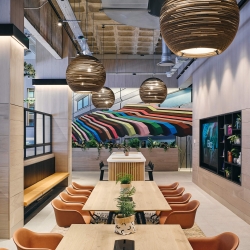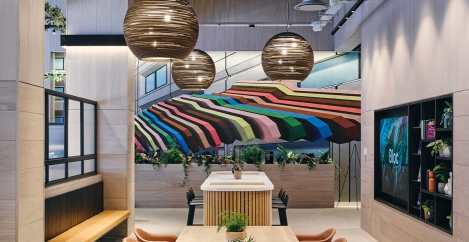June 23, 2022
BCO Conference challenges the office sector to up its game
 Regarded as one of the property sector’s leading events, the BCO Annual Conference saw key players from all parts of the office industry flock to Manchester – the vibrant, modern cosmopolitan powerhouse that is celebrated around the world for being the UK’s most competitive, economically productive, liveable and vibrant region. In her keynote, Joanne Roney, chief executive of Manchester City Council, said that the most demanding, challenging and important priority is climate change, closely followed by making a positive difference to the lives of the people who live and work in the city.
Regarded as one of the property sector’s leading events, the BCO Annual Conference saw key players from all parts of the office industry flock to Manchester – the vibrant, modern cosmopolitan powerhouse that is celebrated around the world for being the UK’s most competitive, economically productive, liveable and vibrant region. In her keynote, Joanne Roney, chief executive of Manchester City Council, said that the most demanding, challenging and important priority is climate change, closely followed by making a positive difference to the lives of the people who live and work in the city.
The two-day 2022 conference championed the host city’s commitment and addressed the key issues of human and environmental health, while exploring how the sector is playing and can play a bigger role in shaping a happier and healthier future for people and planet. “The recent disruption to how we live and work has accelerated a move to alternative ways of thinking about our workplace,” stressed BCO president and conference chair Mark Kowal. “We now have an unprecedented opportunity to readdress the role of the office in our lives, and shape how buildings can encourage innovative and fresh thinking, while introducing greener solutions.”
The developer perspective panel certainly reflected Kowal’s sentiment. “It’s about making places, not building spaces”, argued Martyn Evans, creative director of U+I. “We need to make the city and the workplaces within it work better for everybody. Our lives have changed, and so must our approach.” Chief executive of Bruntwood Chris Ogelsby reiterated the occupier prerogative to lure in and keep the best talent. “Location, location, location” used to drive the decisions, he said, but alongside location there is now equal focus on specification, flexibility, amenities and all the things that contribute towards the betterment of a community.
Fellow panellist Phil Mayall of Muse Developments & ECF agreed, adding “it’s not about building buildings, it’s about ripping down barriers”. Mayall stressed the importance of community ownership of place to promote not just identity and inclusivity but innovation. To achieve this, there needs to be a healthier convergence between occupiers and developers, he said.
Cue the occupier panel. The workplace leads at NatWest, IBM and Ericsson are taking heed of the lessons learned throughout the covid crisis and are transforming their people and place strategies accordingly. Working across disciplines, including HR, FM, IT and ESG teams, they are driving purpose and meaning, aiming to empower their employees and improve the overall experience. The line between empowering employees and pandering to their expectations seems somewhat blurred, however, and the long-term impact of hybrid and flexible working is still an area of concern for two of the three workplace strategists.
For or against?
Since there is a direct correlation between experience and engagement, and bearing in mind the raging talent war, the employee experience has to be front and centre of any real estate strategy, argued the occupiers. “Accept the challenge,” urged Katsikakis. “It’s game on. It’s time to redefine the purpose and value of the office, for people, society and the planet. We can’t be complacent or go back to how things were. Or it’ll be game over.”
The ‘game on or game over?’ question underpinned the Futurenauts concluding (and hilarious) keynote: “Instead of knocking down perfectly good buildings to build new ones we don’t need, to house businesses that are pushing us off the cliff edge while making people commute in to do pointless jobs they don’t like very much… how about we use this moment to reimagine the system that underpins how we live, work and play?” That prompted a nervous giggle or two from the crowd.
Humans versus planet
Reimaging the system is one thing. Coming up with a blueprint for the ‘what next’ is another – something that the BCO is attempting with its new fit out guide that explains the considerations in achieving numbers of people on floorplans in terms of human behaviour, utilisation, health and wellbeing, and sustainability. In a seminar designed to unravel the rationale behind the guide, the panel stressed that the industry needs to focus on the human experience above all else. Be Inspired Design’s Clare Danahay thinks that can be made possible “by designing spaces that complement the work people are doing, in a way that fuels collaboration, connection and culture.” For Will Poole-Wilson, founder of Will+Partners, it’s about health & wellbeing – that prerogative must drive density. The secret lies in considering sustainability from the outset, added Jane Wakiwaka of The Crown Estate.
But is it possible to do both?
It has been eleven years since the last BCO update and while it may indeed be time to issue guidance, audience members, including Gavin King, director at Chapman Taylor, worry that it may be premature. “We are in the tailwind of the pandemic,” King told me in one of the networking breaks. “We feel that there are too many people looking for answers without knowing what the question is. The density of a workplace needs to be fluid, so a reliance on a fixed density isn’t helpful. Also, the reduction in the space utilisation set out in the new BCO guidance worryingly drops the utilisation from 80 percent to 60 percent, whilst increasing the ratio from 8 to 10m2 per person. There is a very real danger we will be designing buildings that are bigger than we need, which will have an immediate and long-term impact on carbon footprint.”
Lead author Neil Pennell of Landsec re-emphasised that the guide is just that – a guide, a starting point of conversation. As such, the BCO welcomes feedback while the draft is in motion.

Jo Sutherland is Managing Director of Magenta Associates.
Main image: Bloc from Bruntwood, winner of a BCO Award













